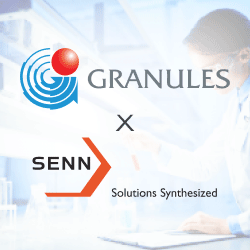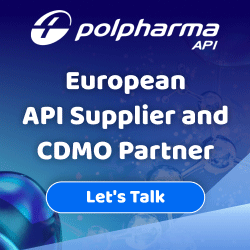Overview of spray drying solutions (amorphous & spray dried dispersions) for the solubility & bioavailability enhancement of APIs, HPAPIs, etc.
Q1. What is spray drying technology?
Spray drying is a widely used technical method to produce fine particles, coarse powders, agglomerates or granulates in various industries. Ever since it was first discovered, the spray drying technology has been improved concerning its operational design and applications. Spray drying is one of the most remarkable technologies currently used in the pharmaceutical industry.
Spray drying is an interesting manufacturing technique for the pharmaceutical industry since it uses a one-step process for formation and drying of powders. Spray drying effectively uses the principle of surface area enlargement. As a result of the atomisation of liquids, fine droplets are quickly and gently dried in a hot air stream.
It is a continuous process that converts a liquid feed into a powder and is an ideal process when precise attributes such as particle size, morphology and stability are required. Using this technique the number of unit operations is reduced, scale up and production efficiencies are increased, and costs are reduced, especially since spray drying is a technique which can be easily automated and equipped for in-line pharmaceutical product analysis.
Spray drying solutions have primarily been used in formulating small molecule drugs with low solubility, however, it is increasingly being applied to the processing of large biomolecules and biopharmaceuticals. Developers and manufacturers are frequently turning to spray dried dispersions (SDDs) as a means of overcoming the solubility challenges presented by many new medicines.
With more molecules being developed with poor aqueous solubility, spray drying solutions such as spray drying of pharmaceutical active ingredients are becoming an important part of development processes, and investments across the industry are being made for increased capacity and expertise to ensure the technology is accessible to allow drugs to be taken through to commercialisation.
The advantages of spray drying APIs and excipients are:
- Drying and shaping of the particle in one step
- Continual processing
- Fully automated procedures
- Control over final product dispersibility
- Gentle drying of temperature sensitive pharmaceutical products
- Large product throughput
- Scalability
Q2. What are the applications of spray drying technology in the pharmaceutical industry?
The remarkable flexibility in tailoring the properties of the final powder pharmaceutical formulations and the gentleness of the process and its economic feasibility when compared with competing technologies such as freeze drying, led to spray drying’s proliferation in multiple industrial applications including cosmetics, fine chemicals, detergents, polymers, excipients and pharmaceuticals.
Some pharmaceutical applications of spray drying include:
- Spray drying solutions for solid dispersions
Although new drug candidates show great promise in its efficacy, further development is limited due to their poor solubility. Spray drying solutions can enhance the solubility and bioavailability of poorly soluble drug molecules and solid dispersions by creating amorphous solid dispersions or spray dried dispersions (SDDs). The manufacturing process of amorphous solid dispersion using a pharmaceutical spray dryer is straightforward. In general, API and inert polymer are dissolved in organic solvents and spray dried to produce solid dispersion powder.
- Spray drying solutions for APIs (spray drying of pharmaceutical active ingredients), high potent drugs and coprocessed excipients
Spray drying API, co-processed excipients and a polymer carrier in a stable amorphous solid dispersion, results in improved dissolution rates and enhanced bioavailability of poorly soluble drug molecules. For high dose drugs, spray drying can enable reduced tablet size by producing powder that is suitable for compression.
- Microencapsulation
Spray drying is one of the most widely used microencapsulation techniques, since it provides rapid evaporation of water and maintains low temperature in the particles. Prior to the spray drying process, the wall material is mixed with the suspension containing encapsulated components through intensive homogenization.
- Taste masking
Taste masking is defined as a perceived reduction of an undesirable taste that would otherwise exist in oral complex pharmaceutical formulations. While there are various techniques to achieve taste masking of bitter drugs, the spray drying process has emerged as a simple and viable approach. The major highlight of this technique is that the taste is masked without interfering with the release of drug in the gastric environment which makes it a very suitable technique for taste masking of immediate release dosage forms meant for oral administration.
- Modified release complex pharmaceutical formulations
Modified release complex pharmaceutical formulations designed using spray drying process can be in the form of a micro capsule, microsphere or microparticle. A microcapsule can be defined as an active substance which is covered by a shell or coat by forming a core-shell reservoir structure.
- Dry powder for inhalation
The spray drying technique is one of the methods used to prepare medicinal particles intended for pulmonary delivery using dry powder inhalers. Advantages of spray drying include the ability to incorporate a wide range of excipients into the spray-drying feedstock, which could modify the aerosolization and stability characterizations of the resultant powders, as well as modify the drug release and absorption profiles following inhalation.
- Aseptic production with spray drying
To achieve a homogeneous mixture, the particle size distribution of the excipient(s) must match that of the API or highly potent drug (HPAPI). In a one-step-operation, aseptic spray drying can turn a sterile solution into sterile particles of the required size with no risk of introducing impurities.
Q3. How does large scale spray drying (industrial spray drying) for pharmaceutical active ingredients occur?
As noted above, the transformation of a fluid material into dried particles via spray drying is completed in a single step. However, there are different stages involved in the commercial pharmaceutical spray drying process including atomization, droplet-to-particle conversion and particle collection.
Spray drying involves the spraying of a liquid feed formulation (solutions, suspensions, emulsions) into a hot drying medium (air, nitrogen). Pharmaceutical API spray drying is a unique method of drying that relies on atomization to create a uniform, free-flowing powder and allows heat exposure to be kept to a minimum. The droplets formed by the atomization process are dried through solvent evaporation to form particles which are collected as a dry powder.
The industrial spray drying process consists of the following steps:
Step 1: Preparation of the liquid/slurry or feed preparation
Active substances are homogenized into emulsions, suspensions, solutions or slurries prior to spray-drying and are dried into functional ingredients.
Step 2: Adding the liquid feed to the pharmaceutical spray dryer
The emulsion, suspension or solution made up of a solvent and substances requiring commercial pharmaceutical spray drying (API Spray drying) is loaded into the pharmaceutical spray dryer for atomization.
Types of pharmaceutical spray dryers:
- Open cycle systems (aqueous feeds)
- Closed cycle systems (flammable solvents, highly toxic products & oxygen sensitive products)
- Semi-closed cycle systems
- Co-current flow dryers
- Counter-current flow dryers
- Mixed flow dryers
- Automatic & semi automatic dryers
- Vertical/Horizontal dryers
Step 3: Atomization of the liquid feed to create droplets
The term atomization refers to the reduction of particle size of feed in fluid state. Atomization is used to create optimum conditions for evaporation of liquid solvents. It leads to development of pharmaceutical spray dried materials or pharmaceutical products having predetermined, desired qualities via commercial pharmaceutical spray drying. Nozzles and rotary atomizers are used to form the sprays.
Step 4: Drying of the droplets in a heated air stream
The drying process can be described as having two phases: the constant-rate period and the falling-rate period. In the constant-rate period, moisture evaporates rapidly from a saturated surface via diffusion through the stationary air film at a rate sufficient to maintain saturation. In the falling-rate period and as moisture removal progresses, the solute dissolved in the liquid reaches a concentration beyond its saturation to form a thin shell at the droplet surface.
Kinetically, this stage marks a transformation from low- to high-temperature drying. Following this, and depending on inlet temperature, feed viscosity, and atomization variables, the droplets may follow one of two principal pathways, creating either dry, small-dense or large-hollow particles.
Step 5: Collection of the dried particles
Once the liquid feed is converted into dry droplets, they are collected in a cyclone or drum apparatus. The dried powder is separated from the gas stream prior to collection. In almost every case, API spray drying chambers have cone bottoms to facilitate the collection of the dried powder. When the coarse powder is to be collected, they are usually discharged directly from the bottom of the cone through a suitable airlock, such as a rotary valve.
Benefits of spray drying of pharmaceutical active ingredients (API crystal, high potent drugs, etc.):
- Increases in solubility and bioavailability of poorly soluble drug molecules
- Powders for processing into solid oral dosage forms (tablets, capsules, granules)
- Higher drug loading
- Improved therapeutic efficacy, safety and tolerability
- Scalability
- Modified and controlled release dosage forms
- Synthesis of heat sensitive APIs and API crystals
Q4. What are spray dried dispersions (SDDs)? What are the advantages?
Amorphous solid dispersions (ASD) are a common formulation approach for orally delivered small molecule active pharmaceutical ingredients (APIs) whose oral bioavailability is limited by dissolution rate and/or solubility in the gastrointestinal tract. A common approach to manufacturing ASDs is spray drying.
Spray-dried dispersion (SDD) technology is a powerful formulation tool to enhance the bioavailability for compounds with low solubility — a problem encountered with an estimated 60-90 percent of compounds in early development. An SDD is a single-phase, amorphous dispersion of a drug in a polymer matrix. It is a solid solution with the compound molecularly "dissolved" in a solid matrix.
As the name suggests, SDDs are obtained by dissolving drugs and polymers in an organic solvent and then spray-drying the solution. The formulation and process conditions are chosen so that the solvent quickly evaporates from the droplets, allowing insufficient time for phase separation or crystallization.
Characterization of the SDD and modeling of process conditions can be used to minimize or eliminate the risk of solid state recrystallization if an API demonstrates or is suspected to be at risk for crystallization. This is done by characterizing the SDD, then using that information to define process conditions with appropriate constraints to manufacture a dispersion with the desired attributes.
In recent years, contract manufacturing spray products as well as manufacturing of amorphous dispersions via spray drying have gained considerable traction with the commercialization of numerous products. Additionally, increased access to and familiarity with small-scale spray drying equipment has enabled formulation scientists to include spray-dried dispersions (SDDs) early in compound screening and drug development.
Advantages of Spray-Dried Dispersions (SSDs):
- Solubility enhancement
- Long term stability
- Facile scale up
- Excellent manufacturability
- For high dose drugs, spray-drying enables reduced tablet size by improving compression properties of drug powders.
Q5. Which are some of the companies offering spray drying services?
There are various CMOs (Contract manufacturing organizations) and CDMOs (contract development & manufacturing organizations) offering API spray drying, development of pharmaceutical spray dried materials and contract manufacturing of spray products.
Zach System
Zach System provides contract pharmaceutical large scale cGMP spray drying services for APIs and high potent drugs at R&D, pilot and commercial scale using flammable solvents or water. They offer contract manufacturing of spray products or spray dried products including low endotoxin excipients.
AMRI
AMRI conducts screening for amorphous dispersions (amorphous solid dispersions) using manual experiments, where the particular combination of methods used — including large scale cGMP spray drying, rotary evaporation and lyophilization — are based on the properties of the API and other excipients used.
Siegfried AG
Siegfried offers large scale cGMP spray drying with a pilot spray dryer, which is suitable for use with flammable solvents & can operate with hazardous air pollutant solvents. The API GMP spray drying facilities are closed looped with nitrogen.
Micro-Sphere SA
Micro-Sphere offers GMP spray drying facilities for APIs, aqueous and organic solutions, highly potent drugs (HPAPIs), proteins and capsule filling. They offer the development of pharmaceutical spray dried materials under GMP conditions. Their range of services include API spray drying, spray chilling, capsule filling, etc.
All Suppliers












 Zach System is committed to providing Highly Customized Solutions for all your Development Programs.
Zach System is committed to providing Highly Customized Solutions for all your Development Programs.






